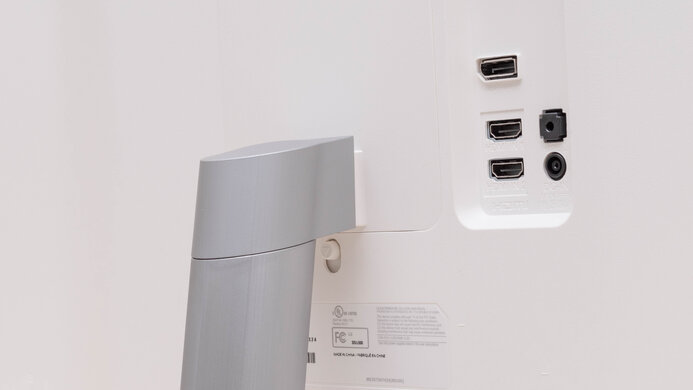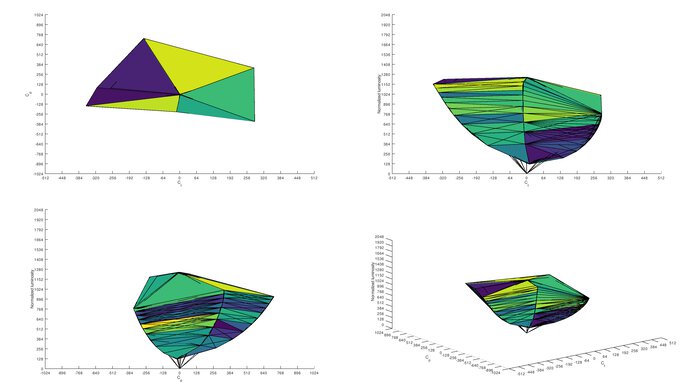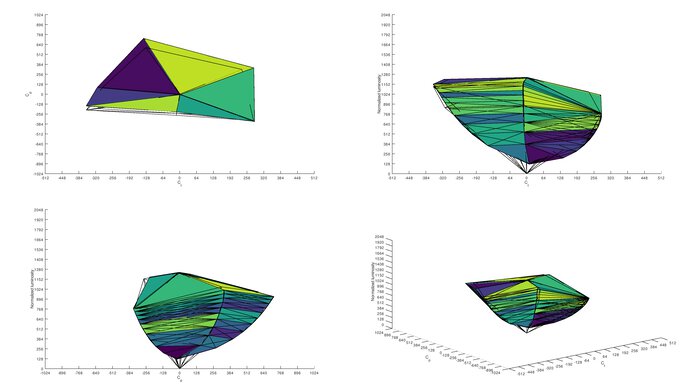The LG 32UL500-W is a good budget-friendly 4k monitor. It gives you plenty of screen space for multitasking, and it delivers incredibly sharp images and text. It's better suited for a dark to moderately-lit room, as it can produce deep blacks but doesn't get bright enough to overcome glare. The viewing angles are adequate and should be fine for sharing text documents; however, there's still some loss of image accuracy when viewing from the side, so it's not the best option if you need to share work that requires precise color reproduction. It has low input lag and variable refresh rate (VRR) support if you want to game on it, but the response time is a bit slow, which results in blurrier images in fast-moving scenes. Unfortunately, the ergonomics are terrible as it only allows for tilt adjustment, and even though it supports HDR, it doesn't get bright enough to make highlights pop.
Our Verdict
The LG 32UL500-W is a good monitor overall. It has a large screen and 4k resolution that make it a good option for work and media consumption. However, it's hard to place the screen the way you like because it has terrible ergonomics. Also, glare might be an issue because it doesn't get very bright. It has low input lag and VRR support for gaming, but the response time is a bit slow, so images look a bit blurry in fast-moving scenes. Unfortunately, it can't deliver a true HDR experience due to its low HDR peak brightness.
-
Large screen and high resolution.
-
Deep blacks.
-
Incredible text clarity.
-
Flicker-free.
-
Allows for tilt adjustment only.
-
Glare might be an issue.
-
Doesn't get bright enough for true HDR.
-
Images look slightly inaccurate from the side.
The LG 32UL500-W is good for office use. It provides you plenty of screen space for multitasking, and text looks incredibly sharp thanks to its high resolution. The viewing angles are adequate, good enough for sharing text documents, but it isn't ideal if you need to share work that requires perfect image accuracy. Unfortunately, even though it has good reflection handling, it doesn't get very bright, so glare can be an issue in well-lit rooms. Also, the ergonomics are terrible because it only allows for tilt adjustment.
-
Large screen and high resolution.
-
Incredible text clarity.
-
Exceptional SDR color gamut.
-
Flicker-free.
-
Allows for tilt adjustment only.
-
Glare might be an issue.
-
Doesn't get bright enough for true HDR.
-
Images look slightly inaccurate from the side.
The LG 32UL500-W is decent for gaming. It has a large screen and high resolution to deliver an immersive gaming experience, but it's better suited for slower-paced games because the response time is on the slow side. Input lag is very low, and it supports variable refresh rate technology to reduce screen tearing. It has a good contrast ratio to produce deep blacks, making it great for gaming in the dark. The viewing angles are adequate, good enough for co-op gaming, as long as you don't mind a slightly inaccurate image.
-
Large screen and high resolution.
-
Deep blacks.
-
VRR support.
-
Allows for tilt adjustment only.
-
Doesn't get bright enough for true HDR.
-
Response time might be too slow for fast-paced games.
The LG 32UL500-W is good for media consumption. It has a 32 inch screen and a 4k resolution to deliver an immersive viewing experience. It can produce deep blacks, making it a great choice for dark rooms. The viewing angles are quite good for a VA panel and should be fine for sharing content casually, but images still look slightly inaccurate when viewed from the side. Also, the stand doesn't allow for swivel adjustment, making it harder to place the screen to your optimal viewing position.
-
Large screen and high resolution.
-
Deep blacks.
-
Exceptional SDR color gamut.
-
Flicker-free.
-
Allows for tilt adjustment only.
-
Glare might be an issue.
-
Doesn't get bright enough for true HDR.
-
Images look slightly inaccurate from the side.
The LG 32UL500-W is good for content creation. It has an exceptional SDR color gamut with full sRGB coverage and outstanding Adobe RGB coverage. There's plenty of screen real estate to place multiple windows side-by-side, and the 4k resolution lets you see every tiny detail of your work. Although the viewing angles are adequate, there's still some loss of image accuracy when viewing off-center, so it's not the best option for sharing your work with coworkers and clients, especially if image accuracy is important. Lastly, it has terrible ergonomics, which makes it harder to place the screen for optimal viewing.
-
Large screen and high resolution.
-
Deep blacks.
-
Exceptional SDR color gamut.
-
Flicker-free.
-
Allows for tilt adjustment only.
-
Glare might be an issue.
-
Doesn't get bright enough for true HDR.
-
Images look slightly inaccurate from the side.
-
Large screen and high resolution.
-
Allows for tilt adjustment only.
-
Doesn't get bright enough for true HDR.
- 7.3 Mixed Usage
- 7.2 Office
- 7.1 Gaming
- 7.7 Media Consumption
- 7.8 Media Creation
- 6.9 HDR
Changelog
- Updated Dec 08, 2023: Changed the Text Clarity score to 9.0 to better reflect other monitors that we've tested.
- Updated Sep 09, 2022: We added text for the new macOS Compatibility box added as part of the test bench 1.2 update process.
- Updated Sep 09, 2022: Updated to Test Bench 1.2, resulting in changes to the results and scores with the Response Time and Input Lag. Added tests for Console Compatibility and macOS compatibility and made minor changes to other tests, which you can see in our Changelog.
- Updated Jan 19, 2021: Review published.
- Updated Jan 13, 2021: Early access published.
Check Price
Differences Between Sizes And Variants
We tested the 32 inch LG 32UL500-W, and it's the only size available. The LG 32UL750-W is very similar, but it has more features such as a USB-C port and height adjustment. It's also advertised to have higher peak brightness; however, we haven't tested it. There are many monitors in LG's 4k lineup with various configurations, some of which you can see in the table below.
| Model | Size | Panel Type | Stand | Note |
|---|---|---|---|---|
| 32UL500-W | 32" | VA | Tilt only | - |
| 27UL500-W | 27" | IPS | Tilt only | - |
| 27UL550-W | 27" | IPS | Tilt/Height/Pivot | - |
| 27UL600-W | 27" | IPS | Tilt only | DisplayHDR 400 |
| 27UL650-W | 27" | IPS | Tilt/Height/Pivot | DisplayHDR 400 |
| 32UL750-W | 32" | VA | Tilt/Height | DisplayHDR 600, USB-C with 60W PD |
| 27UL850-W | 27" | IPS | Tilt/Height/Pivot | DisplayHDR 400, USB-C with 60W PD |
| 32UL950-W | 32" | Nano IPS | Tilt/Height/Pivot | DisplayHDR 600, USB-C (Thunderbolt 3) |
If someone comes across a different type of panel or their LG 32UL500-W doesn't correspond to our review, let us know and we'll update the review. Note that some tests, such as gray uniformity, may vary between individual units.
Our unit was manufactured in November 2020; you can see the label here.
Compared To Other Monitors
The LG 32UL500-W is a good 4k monitor overall. It provides tons of screen space for work and delivers sharp images and text. However, it may struggle with glare because it doesn't get very bright, and it has terrible ergonomics. It performs similarly to the BenQ EW3270U but with a slower response time.
For more options, you can check out our recommendations for the best office monitors, the best 4k monitors, and the best 32-inch monitors.
The LG 32UL500-W and the LG 27UK650-W are both 4k monitors with a 60Hz panel, but the 32UL500-W has a 32-inch VA panel while the 27UK650-W has a 27-inch IPS panel. The 27UK650-W is better overall because it has wide viewing angles, better ergonomics, and gets much brighter to combat glare. It also has a better response time if you want to game. However, the 32UL500-W provides more screen real estate, and content creators might prefer its wider Adobe RGB and DCI P3 coverage.
The LG 32UL500-W and the Dell S3221QS are very similar as they're both 32 inch VA panel monitors with a 4k resolution and a 60Hz refresh rate. However, the Dell has a 1800R curved screen while the LG is flat. The Dell gets a bit brighter, making it a better choice for bright rooms, and it's a little bit better in terms of ergonomics because it allows for height adjustment. For content creators, the LG has better Adobe RGB and DCI P3 coverage. On the other hand, the Dell has more extra features, including two USB ports and a Picture-in-Picture/Picture-by-Picture mode.
The LG 32UL500-W and the BenQ EW3270U are very similar. The main differences are that the BenQ gets a little brighter, and it has a better response time, making it a better choice if you plan to game on it. The LG is better suited for content creation because it has a better color gamut, but color accuracy is quite bad out of the box, so it might need calibration.
The LG 32UL500-W is a more budget-friendly VA variant of the LG 32UL950-W. For productivity, the 32UL950-W is a better choice because it has wide viewing angles, and it allows for more ergonomic adjustments. It has more features like two USB-C ports, one of which supports Thunderbolt 3, and it has a Picture-in-Picture/Picture-by-Picture mode. It also gets brighter to combat glare, but it doesn't handle reflections as well as the 32UL500-W. The 32UL500-W is a better choice for dark rooms due to its high contrast ratio, and it has a better SDR and HDR color gamut.
Test Results
The LG 32UL500-W has a simple design that's well-suited for most office settings. The stand is a variation of their 'ArcLine' design and looks almost identical to the LG 32UL950-W's. Compared to other recent monitors, the borders are on the thicker side, giving it a more budget look.
Unfortunately, the ergonomics are terrible. It only allows for tilt adjustment, so you might have trouble getting the best viewing position, and it also makes it harder to share your screen with others.
The LG 32UL500-W doesn't have a local dimming feature. The video above is provided for reference only.
The LG 32UL500-W has okay SDR peak brightness. There's no brightness variation when displaying different content, but it isn't quite bright enough to combat glare, so it's best suited for a dark to moderately-lit room. This is lower than the advertised 300 cd/m².
We measured the SDR peak brightness in the 'Custom' Picture Mode with Brightness set to max. We achieved 270 cd/m² in the 'HDR Effect' Picture Mode, but color accuracy is significantly worse, which is why we used 'Custom'.
The HDR peak brightness is sub-par. It's again very consistent across different content, but it's only slightly brighter than in SDR and not enough to make highlights stand out the way they should in HDR content.
We measured the HDR peak brightness in the 'HDR Standard' Picture Mode with Brightness set to max.
The LG 32UL500-W's horizontal viewing angles are adequate, quite good for a VA panel. It should be fine for sharing content casually or playing co-op games; however, it might not be ideal for sharing work that requires perfect image accuracy because there's some gamma shift almost as soon as you move off-center. There's also an odd behavior with the brightness as it gets brightest around 10 degrees to the right, but it shouldn't affect image quality unless you're constantly moving around.
The vertical viewing angles are mediocre, which means that images look inaccurate if you mount the monitor above eye level.
Our LG 32UL500 has excellent gray uniformity; however, this can vary between units. Dirty screen effect is very minimal, but there are a few spots that appear darker, mostly along the edges. That said, there isn't a huge difference between the lighter and darker areas and shouldn't be noticeable in most content. Uniformity is slightly better in near-dark scenes, but the backlight is more visible along the left and right edges.
Black uniformity is decent; however, this can vary between individual units due to manufacturing tolerances. There's a small amount of clouding throughout, as well as some backlight bleed at the top and bottom-left corners. This is only visible when viewing dark scenes in a dark environment.
The LG 32UL500 has bad accuracy out of the box, but this can vary between units. Most colors and shades of gray are inaccurate. The color temperature is much warmer than our 6500K target, which results in a slight reddish tint. Gamma doesn't follow the curve at all, making most scenes appear darker than they should. There's a Rec. 709 color setting, but it's even more inaccurate.
Accuracy is exceptional after calibration. The remaining inaccuracies aren't visible to the naked eye. The color temperature is much closer to our 6500K target, just slightly on the cooler side. Gamma is much better, but very dark and very bright scenes are now too bright.
You can download our ICC profile calibration here. This is provided for reference only and shouldn't be used, as the calibration values vary per individual unit due to manufacturing tolerances, even for the same model.
The LG 32UL500-W has an exceptional SDR color gamut. It covers the entire sRGB color space used in most content, and it has outstanding coverage of the Adobe RGB color space used for photo editing.
The LG 32UL500-W has a good HDR color gamut. It has excellent coverage of the DCI P3 color space used in most HDR content and decent coverage of the wider Rec. 2020.
The DCI P3 coverage is lower than the advertised 95%. This is due to the way we measure DCI P3. We measure DCI P3 by sending a Rec. 2020 signal, but unlike most reviewers, we limit the colors to the DCI P3 primaries. This results in a lower but arguably more accurate measurement.
The HDR color volume is good, but just like in SDR, it has trouble displaying dark colors even though it has a high contrast ratio. It also has difficulty with bright blues, although that's typical for LCDs.
The LG 32UL500-W has a basic 60Hz refresh rate. It's a typical refresh rate for 4k monitors and should be good enough for most uses, but it doesn't provide the smoothest gaming experience. That said, high-refresh 4k monitors, such as the LG 27GN950-B, are still rare and require high-end hardware to achieve frame rates above 60fps. It supports FreeSync and is compatible with G-SYNC to reduce screen tearing; however, G-SYNC only works over a DisplayPort connection.
| Overdrive Setting | Response Time Chart | Response Time Tables | Motion Blur Photo |
| Off | Chart | Table | Photo |
| Normal | Chart | Table | Photo |
| Fast | Chart | Table | Photo |
| Faster | Chart | Table | Photo |
The LG 32UL500 has decent response time at its max refresh rate. It's a bit slow, which results in more motion blur in fast-moving scenes. It isn't the best for gaming, but good enough for slower-pace games. The best overdrive setting is 'Off' because it has the best total response time with the least amount of overshoot.
The LG 32UL500-W doesn't have a Black Frame Insertion feature.
The LG 32UL500-W's input lag is excellent, and it doesn't increase with VRR or HDR enabled. This results in a responsive desktop and gaming experience.
The LG 32UL500-W has a large 32 inch screen that provides plenty of space for multitasking, allowing you to place multiple windows side-by-side. The pixel density is still very high despite the bigger screen size, so images and text look incredibly sharp.
The LG 32UL500 has a few additional features, including:
- Black Stabilizer: Makes objects more visible in dark scenes.
- DFC: Dynamically adjusts the brightness and contrast according to the content to improve picture quality.
- Reader Mode: Blue light filter to reduce eye strain.
- HDR Effect: Picture mode that simulates HDR colors in non-HDR content.
Comments
LG 32UL500-W: Main Discussion
Let us know why you want us to review the product here, or encourage others to vote for this product.
- 21010
Hello, I absolutely love the settings you have come up with, I’m playing on ps5 and are their any settings for this monitor that you may have found tho make gaming look more bright colourful and vivid without using HDR and the vivid mode.. or should I turn everything up but a couple numbers of the same amount.
The custom settings looks great but it’s doesn’t bloom, if you know what I mean.
Edited 4 months ago: Missed a bit - 21010
I have this monitor as a work monitor, and i notice brightness flicker in darker scenes.
Update: Changed the Text Clarity score to 9.0 to better reflect other monitors that we’ve tested.










































































































